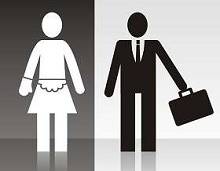GENDER STEREOTYPING: So what are the tough new rules on gender stereotype adverts?
They end outdated expectations of stereotype duties performed by men and women.
Examples include cleaning and washing clothes by females and basic domestic tasks carried out by men.
A report called ‘Deceptions, Perceptions, and Harm‘ made the conclusions. It says British advertising needs to take a tougher line on ads featuring gender stereotyping.
The report author claims depicting gender stereotypes in ads has a potential to reinforce expectations. It focuses on how gender groups or individuals should appear or behave.
The concern relates to the way people consider their own aspirations and potential. Even so, new standards will not stop gender stereotyping altogether. But, the new gendered advertising rules ban certain scenarios.
Scenarios Banned by Gender Stereotyping Rules
Some examples of the scenario ban include:
 A female with the sole responsibility of cleaning up a family mess.
A female with the sole responsibility of cleaning up a family mess.- A male failing to conduct some basic household chores.
- Advertisements that suggest an activity is ‘inappropriate‘ for girls or boys because it gets associated with the other sex more often.
The change of focus will be ensuring adverts do not offend, harm, or mislead. The report offers new standards that aim to make sure gender ads do not contain anything harmful.
The industry is convinced that the standards will continue creating fantastic adverts.
British Advertising Agencies
Many advertising agencies see the issue as a hot topic. They realise things need to change.
The days of men taking the lead role in advertisements are near the end.
One of the London-based agencies said they discuss this topic a lot. They look at the roles within the content that they produce and see its importance.
They agreed it is important to reflect society accurately. That requires a need to question the gender make up of their casting couch.
Improving Boardroom Diversity
The increase in female FTSE 100 board members now stands at 33% – a notable rise from 12.5% less than ten years ago [2011].
The findings come from a recent Hampton-Alexander Review. Even so, despite having 349 females now sitting as board members, there is still room for further improvement.
New Stereotyping Standards from 2018
The new advertising standards for gender stereotypes comes into force from 2018. Adverts that are in breach of the new rules will get withdrawn. Many people in the industry have welcomed the strengthening to existing policy regulations.
Related News: UK Gender Pay Gap Details Exposed by New Regulations
One psychologist summed up the new stereotyping standards. She said the need to regulate marketing and advertising standards is clear. They must represent the reality of living life as a human being.
That means there is a need to remove the restrictions that they place. The days of funneling girls and boys in separate routes are all but finished.
In the end, the overwhelming majority of individuals fall somewhere between. The blame for creating those gender stereotypes in the first place rests with the marketers.
Ban on Adverts Featuring ‘Harmful Gender Stereotypes’
The ban on adverts that feature ‘harmful gender stereotypes’ or those with a likelihood of causing ‘serious or widespread offence’ came into full force in June 2019.
Some ‘typical’ situations now have a strong likelihood of failing to meet the new rule for advertising gender stereotypes, such as adverts which:
- Are aimed at new mothers portraying that keeping a home tidy or looking good has more importance than having emotional wellbeing.
- Disparage a man for carrying out something considered as being a ‘stereotypical’ role for a female.
- Show a male person resting with his feet up while a female cleans the house.
- Show either of the genders failing to perform a task due to their gender (e.g. a woman failing to park a vehicle or a man failing to change a baby’s nappy).
Note: The changes to gender stereotypical advertising do not prevent the use of ‘ALL’ gender stereotypes. The Advertising Standards Authority (ASA) said the intention is to identify, and prohibit, certain types of ‘specific harms’.
RELATED NEWS STORIES
Articles on Workplace and Benefits: Hot off the press workplace news articles from A to Z.
Gender Pay Gap Declarations: Britain announces new regulations on gender pay gaps.
MoD Relaxes Haircut Rules: Ministry of Defence has softened their approach on body hair.
TUC Failing British Workers: UKIP claims the TUC no longer cares about British workers.
Workplace Safety Records: UK claims one of the best workforce safety records across EU.

